12 Lebanese Mezze Dishes You Need To Try At Least Once, Recommended By A Middle Eastern Recipe Developer
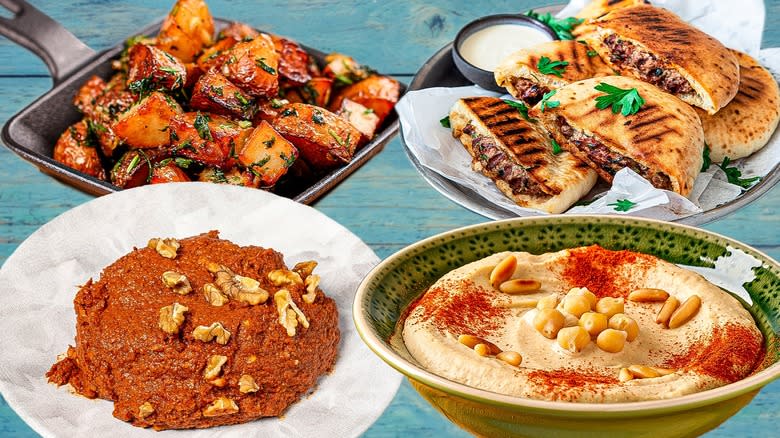
Lebanese cuisine is known for its bountiful mezze plates and platters, shared among family or friends. Folks who are unfamiliar with this style of eating may be confused at the mezze menu, which often has a variety of intriguing dishes all listed before the main courses. Many Lebanese restaurants actually have a relatively small main-course selection, while there are usually numerous mezze options to choose from, depending on the size of the kitchen. Sometimes they're even divided into cold and hot mezze dishes. These colorful, diverse mezze specialties are often the star of the meal, and people sometimes forgo a main course altogether and feast on varied mezze plates instead.
What's great about Lebanese mezze is that the selection offers something for everyone. The dishes include meat, pastries, veggies, dips, and numerous vegan options. They're also texturally diverse, from the smoothest dips to chewy flatbreads to crunchy salads. Mezze platters are a shared celebration of everything that's beautiful about Lebanese cooking, full of seasonal produce, intriguing spices, and big flavors.
Growing up in a Middle Eastern community, my family often got together at Lebanese restaurants for celebrations, holidays, and more. The mezze selections were always the main event, and we would fill the table with them and share every last morsel. Over the years, as a recipe developer and food writer, I've learned how to make mezze at home. While you're probably familiar with hummus and falafel, here are many more of the Lebanese mezze dishes you need to try.
Read more: Restaurant Foods That Always Taste Better Than What You Make At Home
Muhammara
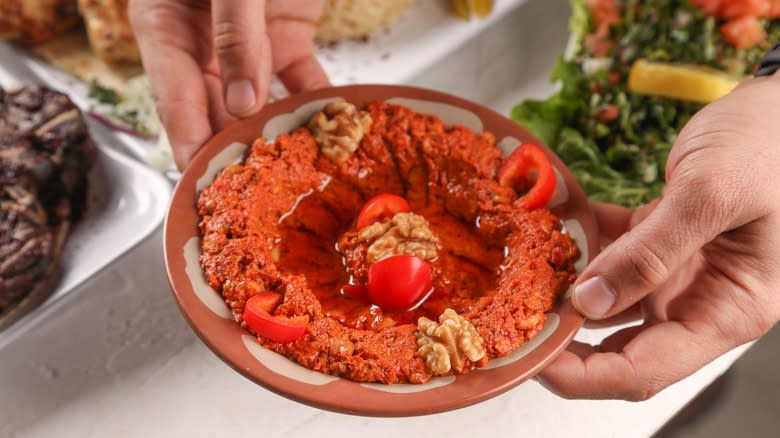
For many people who aren't from the Middle East, hummus is the only dip from the region that they're familiar with. While hummus is a beloved and ubiquitous Lebanese mezze, there's a whole world of other delicious Middle Eastern dips. One of these is a strikingly red blend of walnut and red pepper called muhammara, the Middle Eastern dip that takes sweet and savory to the next level. Its delicate sweetness comes from roasted red peppers and a hint of pomegranate molasses. The molasses also has a slight sourness that lifts the dip, giving it a brightness that you wouldn't expect.
While it originated from Aleppo, Syria, muhammara is spread all over the region, especially in neighboring Turkey and Lebanon. It's a relatively easy dip to make, using a few essential ingredients: olive oil, walnuts, roasted red peppers, pomegranate molasses, and Aleppo pepper. People also sometimes add lemon juice, garlic, and cumin.
The walnuts create the dip's base, adding thick richness without the need for any dairy products, making this dip completely vegan. It's unlike any of the other mezze dips, not only because of its bright color, but because it's sweet, spicy, and fruity. It goes great with bread, and makes for an excellent topping on many sandwiches. You can also eat it alongside vegetables and grilled chicken or fish.
Arayes
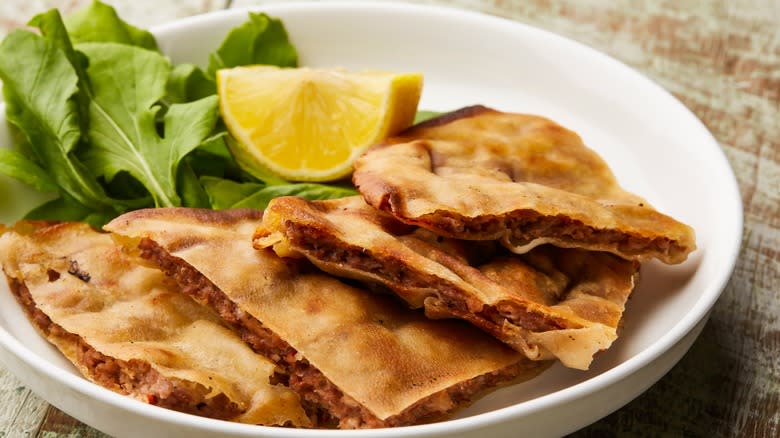
Arayes are a popular street food in Lebanon. They're a mix between a flatbread pie and a kind of Middle Eastern burger alternative, usually cut into quarters to be shared. They're filled with ground beef and usually prepared with onions, garlic and a mix of spices that perfume the meat beautifully. As this specialty is prepared with raw meat and cooked in a pita, beef juices soak into the bread, making the arayes extra luscious. The meat cooks as the bread is toasted until it's crisp on the outside.
This is a comfort food that you can pick up with your hands, and it's the perfect addition to your picnic basket or barbecue table. If you find arayes on the menu at your favorite Lebanese restaurant, they're a must-try. They'll likely be served with a yogurt or garlic dip, and some pickles on the side to break through the richness.
They're also really easy to make at home. The ground meat mixture is basically the same recipe for kofta, which is spread into the inside of thin pita bread. The spices include a blend called baharat, which you should be able to find at any Middle Eastern grocery. Diced onions and minced garlic are mixed in too, along with a drizzle of pomegranate molasses. Once you've filled your pitas with the fragrant meat mixture, brush the outside with some olive oil and grill the arayes in a pan or the oven until golden brown and crisp.
Hummus Bil Lahme

People might be surprised to find out that a Lebanese restaurant's mezze menu may offer a couple of hummus dishes they may not have heard of before. One of these is hummus topped with fragrant meat and pine nuts, called hummus bil lahme. This specialty is named quite literally, as "bil lahme" means "with meat" in Arabic. The smooth, creamy hummus is still the star of this mezze, but the little pieces of grilled spiced beef and toasted pine nuts are incredibly moreish, adding texture and flavor to every bite.
You eat this the same way you would eat plain hummus — just dip a piece of bread straight in, and scoop up the dip and morsels of meat. If you're worried that it will be too filling to eat as a mezze, this won't be the case if you're sharing with others; plus, it's not piled with meat as you might imagine, but served with just enough to get the meal going. In fact, the spices make it quite appetizing, making you want more. In truth, the real risk is that you may want to keep eating this dish and order seconds.
Warak Enab
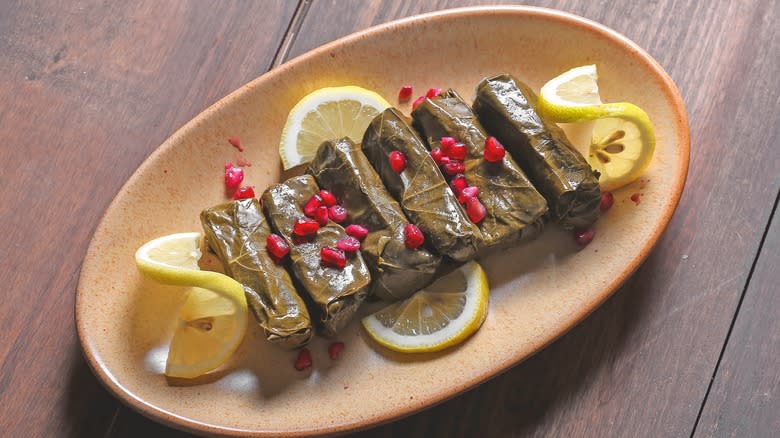
You might know them as dolmas or dolmades, but these delicate appetizers of stuffed grape leaves are called warak enab in Arabic. They're usually on the mezze menu, and could be vegetarian or meaty depending on the restaurant. They're composed of a wonderfully spiced rice and veggie mixture (with or without ground beef) wrapped up tightly with grape leaves into little cylindrical parcels. They're then heated in a broth or a tomato-based sauce, until the stuffing has cooked and the leaves have become soft and tender, but still hold together.
These are incredibly labor-intensive to make at home, so any chance you get to order them already prepared is one you should take. They also add a different dimension to your mezze order, since they don't need to be dipped or wrapped in anything. The fact that you can pick them up and pop them in your mouth also makes them really easy to share. They'll almost always be served with some lemon slices or wedges, which you should squeeze onto them, and enjoy.
Batata Harra
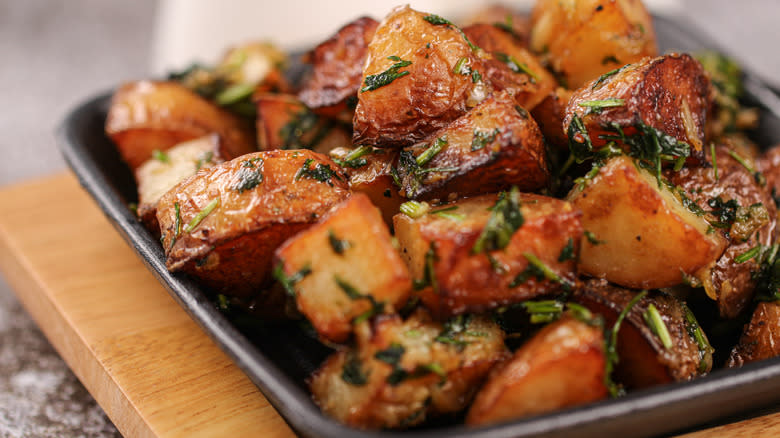
Potato salad is a staple at barbecues and cookouts in many parts of the world. The Middle East is no different. The best thing about Mediterranean-style potato salads in general is that they're no-mayo potato salads, making them lighter and fresher, especially as a side dish or mezze that won't make you feel too full.
With its name meaning "hot potatoes" in Arabic, batata harra is a spicy Lebanese potato dish you should know. It has the subtle kick of chilies, along with seasonings like ground coriander, garlic, and a squeeze of lemon, all coming together to create an incredibly appetizing potato specialty.
The potatoes are tossed in a hot pan with some olive oil until they're crispy on the outside and soft on the inside. Eaten hot or cold, batata harra is a versatile recipe that's packed with herbs and spices. However, when ordered at a restaurant, this dish is considered a hot mezze, and will likely be served alongside other hot mezze dishes. Nonetheless, you don't always have to order it as a mezze; it can just as well be a side dish to your favorite main course.
Mutabbal
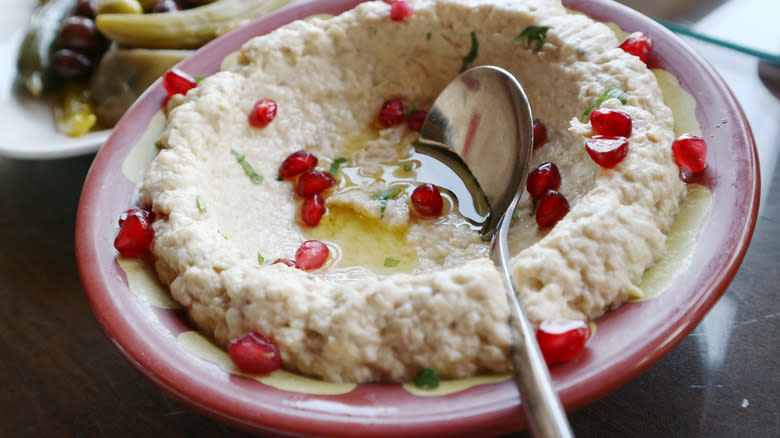
Move over, baba ganoush — there's another eggplant dip that's just as good, but less well-known. Mutabbal is a silky and tangy eggplant dip, and if you're not a fan of baba ganoush, you should consider giving mutabbal a try. The primary difference is that mutabbal is usually smoother and includes tahini. It's extra creamy and tangy, along with being smoky and savory. As a totally vegan dish, you'll be delighted at how velvety mutabbal is. It can convert even the most anti-eggplant person out there.
Mutabbal is so easy to make at home, and all you need is some garlic, eggplant, tahini, lemon juice, salt, and olive oil. The trick is to roast an eggplant until it's silky and soft, before peeling off the skin or scooping out the insides. Then blend the eggplant with the rest of the ingredients, and voilà. You can also mash everything manually with a fork instead. It's great as a dip to scoop up with bread, or for spooning over a piece of grilled fish, chicken, or some roasted cauliflower.
Fattoush
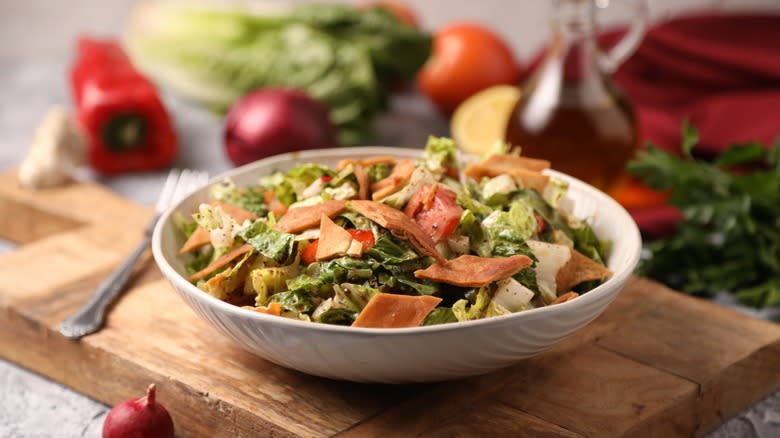
Fattoush is perhaps one of the most beloved salads in the Levant, and it's loved by kids and adults alike. It's not looked at as a boring salad or a healthy food option that you "should" eat — it's commonly craved in its own right. The secret to it is the crunchy baked or fried pita pieces in it (something like Middle Eastern croutons), and the tart and zesty dressing that makes you want to keep coming back for more. There's also an art to eating it, as you alternate between the crunchy bread toppings and the dressing-soaked soggy bits that have fallen to the bottom of the fattoush.
This Lebanese salad is an easy go-to for making a fresh side to any hearty meal, or just to have on its own. Recipes frequently differ, as the dish is made with whatever vegetables are in season, but fattoush is usually a simple green salad with lettuce and cucumber, and the addition of radishes, tomatoes, mint, and green onions. The vinaigrette is often flavored with sumac, and sometimes pomegranate molasses. Mixed with olive oil and some vinegar or citrus juice, this dressing provides the perfect balance of sweet and sour.
Sfeeha
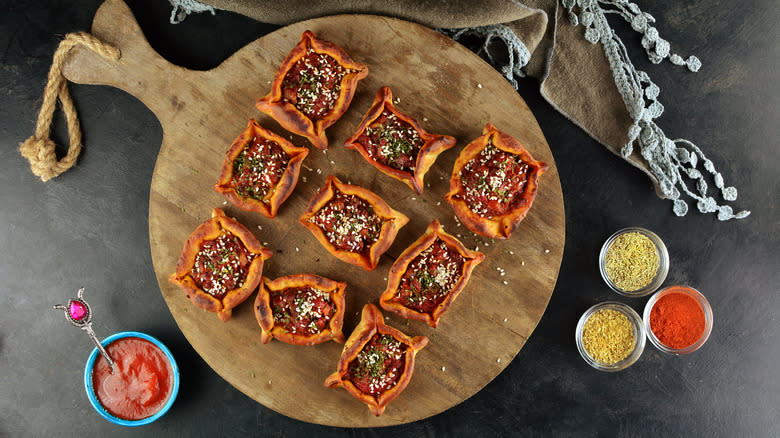
Meat lovers need to try sfeeha, the savory Lebanese pie often included in mezze platters. The pie's meat filling is spiced with a well-balanced seasoning blend that's full of flavor, and it's completely enveloped in tender and fluffy dough. These little savory bites hail from the Lebanese community of Baalbek. The meat usually consists of ground lamb or beef (or a combination of the two), flavored with spices and mixed with some tomato and onion. Optional additions include pomegranate molasses, cayenne pepper, tahini, pine nuts, and more.
Composed of two things — meat and bread — sfeeha is a simple but tasty mezze. Resembling a pie, dumplings, or cheese-free pizza, sfeeha is easy to pick up and eat on the go, or for sharing. The sfeeha can be formed in little bite-size shapes, or in bigger versions often made in the shape of squares with pinched up corners, making them resemble stars. Sometimes they're also just a simple round or oval shape; if you're making them yourself, you can make them into any format you find easiest. You'll find sfeeha served with yogurt, which mellows them out a little and adds a creamy balance.
Fatayer
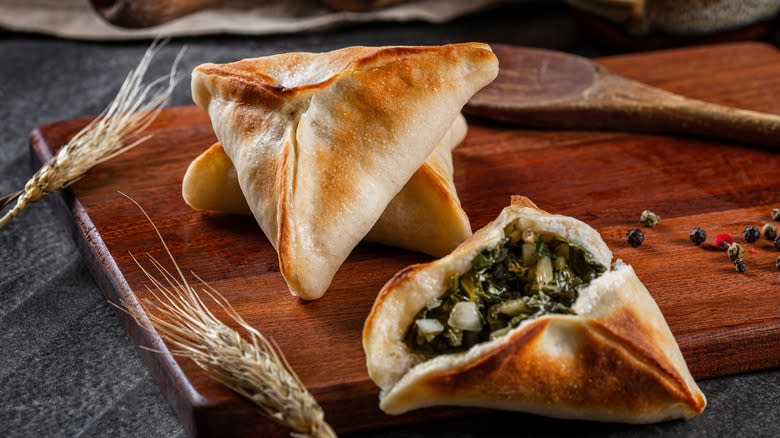
Fatayer pastries are commonly enjoyed as a Lebanese starter or midday snack. They can have a number of fillings, as fatayer is the umbrella term for savory filled pastries. They're like the Lebanese version of an Indian samosa, only they're not deep-fried, but enveloped in soft dough and baked instead. They might have a ground meat filling similar to sfeeha, or you'll likely find the basic but popular spinach fatayer.
A really popular fatayer shape is a closed triangle, but you can find open versions of them in circular or oval shapes. Sometimes you can order an assortment of fatayer, which I recommend if it's your first time trying them.
If you've ever made dumplings before, then these will be a breeze. Plus, the variety of fillings make them exciting, and you can customize fatayer to your liking. They can be perfect snacks to make ahead of time and freeze, to be reheated when you're hungry or have unexpected guests.
Kibbeh
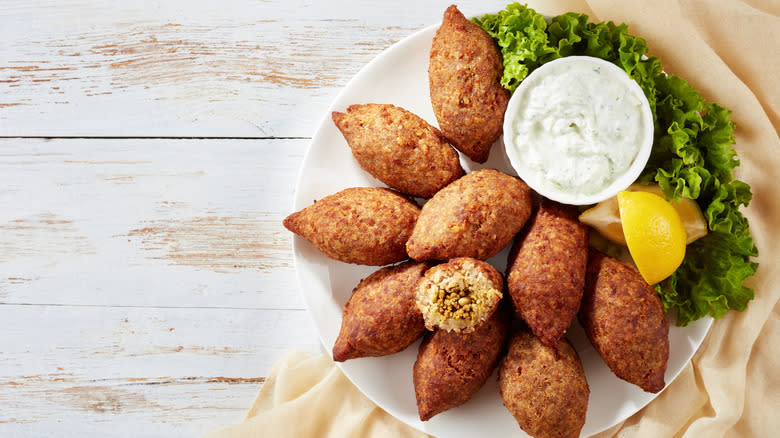
Kibbeh is an oft-underrated meat mezze option at many Lebanese restaurants. Resembling the love child between a meatball and a croquette, this fragrant meat parcel is made with a combination of ground beef or lamb, bulgur wheat, spices, and pine nuts. The spiced ground meat is encased by a meat and bulgur wheat mixture, and formed into lemon-shaped balls.
These are deep-fried, and become really crisp on the outside and fluffy on the inside. If not done well, they can be a little dry. But if you've only tried them once and didn't like them, you should definitely give them another chance, because when done correctly, kibbeh is moist and totally scrumptious.
While kibbeh is served as a traditional mezze plate, you can eat them as a main course too, as they're quite filling. They'll be served with a tahini sauce, which brings out the flavor of the pine nuts beautifully. But pay attention when ordering, because there's another dish called kibbeh nayyeh — and since "neyyeh" means raw in Arabic, you'll be getting something totally different than what you were expecting. Kibbeh nayyeh is a Lebanese raw-meat dish similar to tartare. While I recommend trying this because it's also really tasty, you want to be sure that you're ordering what you actually want to avoid any surprises.
Makanek
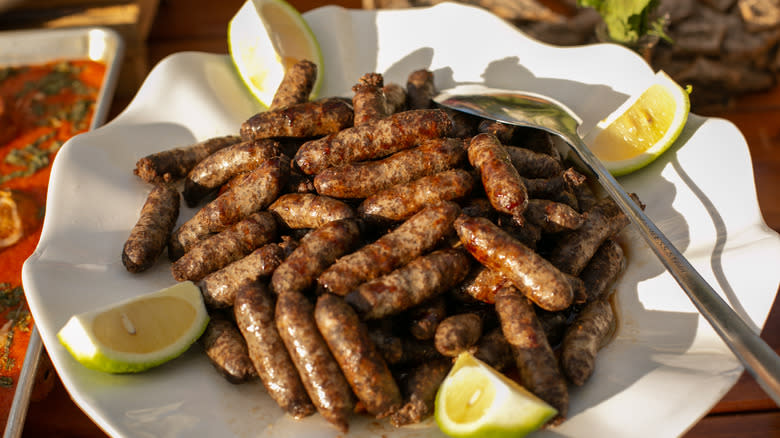
Sausages belong to many cultures around the world, and they're incredibly popular in North Africa and the Middle East, too. If you happen to find Lebanese makanek sausages on a mezze menu, you've got to try them. While they are served throughout Lebanon, they're also enjoyed internationally. They are slightly less known than Lebanese sujuk, but this incredibly tangy, unique meat specialty is worth tracking down.
Makanek links are made with beef or lamb (or both), and these sausages celebrate one particular ingredient: pomegranate molasses. This flavoring — along with seasonings like cloves, nutmeg, cinnamon, ginger, and pepper — makes the sausages tart and spicy, while adding a subtle sweetness. This transforms makanek into the whole package in terms of flavor: salty, sweet, sour, and umami. The links are usually small and thin, like little fingers, but don't let their size fool you. They pack a punch. Usually they're served hot, drizzled in a spiced pomegranate molasses reduction, which you should definitely taste by the spoonful.
Shanklish Cheese
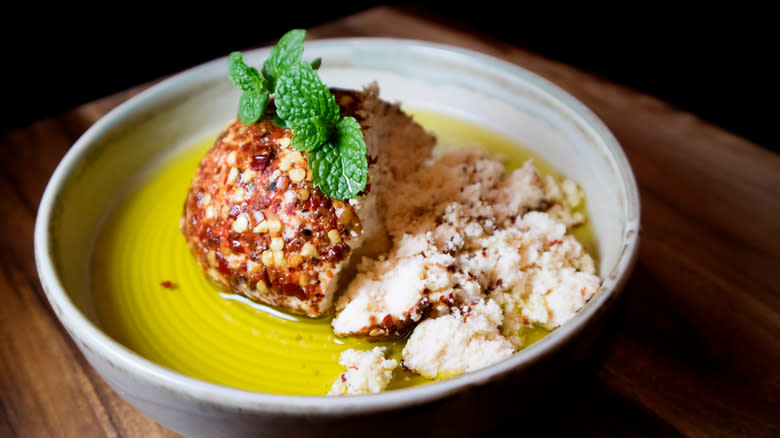
Labneh may be all the rage, but it often steals the spotlight from other Lebanese cheeses that deserve the same renown. Enter shanklish cheese (also sometimes spelled shankleesh). Being another creamy white cheese, shanklish is salty and usually made from cow or sheep's milk. It's often rounded into little balls and suspended in olive oil. It's frequently rolled with za'atar or other spices, like paprika or chile flakes. Either way, it's a luscious cheese that keeps you coming back for more after every bite.
In some restaurants, shanklish is mashed up into a tomato and onion salad, making it a bit more like a chunky cheese dip. It's more salty and pungent than labneh, so shanklish is not typically used as a spread on bread the way a more neutral cheese would be.
Shanklish is a style of cheese eaten all over the region, albeit with different names. It's typically a preserved cheese, and it may be sun-dried, making its texture slightly dry compared to a comparable cheese like feta. You can get fresh shanklish in the Levant, which is a little softer, but if you're Stateside, this specialty is going to be incredibly rare. However you find it, it's a unique type of cheese that's worth a try.
Read the original article on Tasting Table


